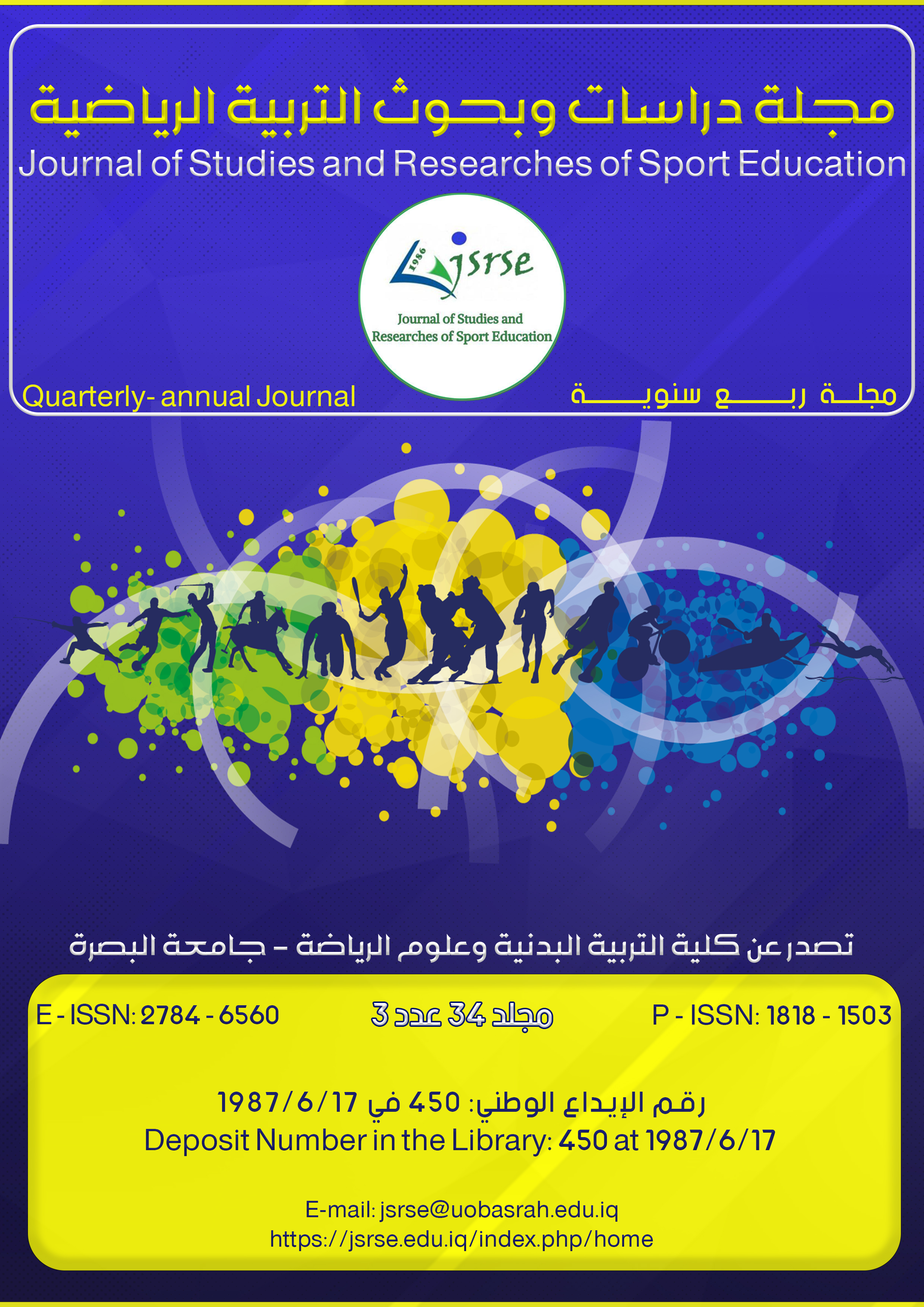مستوى الروح الرياضية لدى لاعبي المنتخب الوطني الفلسطيني لكرة القدم
محتوى المقالة الرئيسي
الملخص
هدفت الدراسة التعرف الى مستوى الروح الرياضية لدى لاعبي المنتخب الوطني الفلسطيني، والتعرف الى الفروق في الروح الرياضية تبعا لمتغيرات (خبرة اللعب في المنتخب، المؤهل العلمي، مكان السكن)، والمنهج المستخدم هو المنهج الوصفي بالاسلوب المسحي، كما استخدمت الاستبانة كأداة للقياس على عينة قصدية بلغت 23 لاعبا وهي تمثل كامل المجتمع. أظهرت النتائج ان مستوى الروح الرياضية لدى لاعبي المنتخب الوطني الفلسطيني كان مرتفعا، كذلك عدم وجود فروق في متغيرات الدراسة (خبرة اللعب في المنتخب، المؤهل العلمي) وكذلك عدم وجود فروق وفقا لمتغير مكان السكن باستثناء مجال احترام التقاليد الاجتماعية حيث كانت لصالح القرية. وأوصى الباحث بضرورة تعزيز الروح الرياضية لدى لاعبي المنتخب الوطني الفلسطيني لكرة القدم، كذلك تطوير برامج متخصصة لتعزيز الروح الرياضية وتطوير القيم الرياضية بين اللاعبين.
تفاصيل المقالة

هذا العمل مرخص بموجب Creative Commons Attribution-NonCommercial 4.0 International License.
المراجع
Ali, M. (2018). The leadership behavior of the coach and its relationship with the sportsmanship of football players. Scientific Journal of Sports Sciences and Arts, Helwan University - Faculty of Physical Education for Girls, 51, 51–77.
Al-Qaddomi, A., Al-Atrash, M., Al-Sa’idyin, M. S., & Sharaf, A. M. Y. (2022). Mood Patterns Among the Female Footballers in Palestine. Journal of Studies and Researches of Sport Education, 32(2).
Al-Qaddoumi, A. (2015). Contribution of coaches to enhancing sportsmanship among players in Palestine. The Seventh International Conference (The Seventh International Conference, Ed.; p. 1535). Faculty of Physical Education - Yarmouk University.
Al-Tai, A. S. R. H. (2022). Psychological courage and interest in the spirit of mathematics for the uneducated Public Administration Selection for the Nineveh Protection Training. JOURNAL OF SPORT SCIENCES, 14(52).
Badran, A., Mahmoud, I., Alshnawi, A., & Ali, M. (2017). The factorial structure of the sportsmanship scale for football players. Scientific Journal of Physical Education and Sports Sciences, Mansoura University - Faculty of Physical Education, 29, 225–245.
Bolter, N. D., Kipp, L., & Johnson, T. (2018). Teaching sportsmanship in physical education and youth sport: comparing perceptions of teachers with students and coaches with athletes. Journal of Teaching in Physical Education, 37(2).
Chantal, Y., & Bernache-Assollant, I. (2003). A prospective analysis of self-determined sport motivation and sportspersonship orientations. Athletic Insight, The Online Journal of Sport Psychology, 5(4), 173–182.
Dorak, F. (2015). The relationship between personality and sportspersonship orientations. The Anthropologist, 19(3), 597–601.
Elendu, I. C., & Dennis, M. I. (2017). Over-emphasis on winning, host-to-win and winning-at-all-cost syndrome in modern sports competitions: implications for unsportsmanship behaviours of sports participants. International Journal of Physical Education, Sports and Health, 4(5), 104–107.
Esa, E. (2015). The Relationship Between Sportsmanship and Emotional Intelligence among High Level Team Sports Players in West Bank-Palestine [Unpublished master’s thesis]. An-Najah National University.
Gonçalves, C. E., e Silva, M. J. C., Cruz, J., Torregrosa, M., & Cumming, S. (2010). The effect of achievement goals on moral attitudes in young athletes. Journal of Sports Science & Medicine, 9(4), 605.
Gorgut, I., & Tutkun, E. (2023). Sportsmanship in sport with athlete perspective. Journal of ROL Sport Sciences, 4(4), 1319–1340.
Haih, M. (2015). The relationship between sportsmanship and motivation among professional football players in the West Bank - Palestine [Unpublished master’s thesis]. An-Najah National University.
Joyner, K., & Mummery, K. (2005). Influences on sportspersonship orientations: Contextual and motivational. Youth Studies Australia, 24(1), 48–53.
Kadhim, M. A. A., Mashi, A. A. A., Al-Diwan, L. H., & Ghazi, M. A. (2024). Understanding the Mechanism of Conducting Benchmark Test for the Infrastructure of Physical Education Curricula in the Age of Artificial Intelligence. International Journal of Elementary Education, 13(1), 8–12. https://doi.org/10.11648/j.ijeedu.20241301.12
MANDOOBMAKKIATI, A., & ABED, Y. (2024). AN ANALYTICAL STUDY OF THE ORGANIZATIONAL CRISES FACING COACHES IN THE IRAQI FOOTBALL LEAGUE. International Development Planning Review, 23(1), 226–236.
Manouchehri, J., Tojari, F., & Hejabi, A. (2015). Determining validity and reliability of Sportspersonship scale among young athletes. Journal of Applied Environmentaland Biological Sciences, 5(7), 354–360.
Mansouri, Nabil, harsh, & Salem. (2022). The role of written sports media in developing the social responsibility of supporters as a means of reducing sports fanaticism. Rawafed Journal for Studies and Research in Sports Sciences, 2(1), 112–132. https://www.asjp.cerist.dz/index.php/en/article/184221
Monacis, L., Estrada, O., Sinatra, M., Tanucci, G., & de Palo, V. (2013). Self-determined motivation, sportspersonship, and sport orientation: a mediational analysis. Procedia-Social and Behavioral Sciences, 89, 461–467.
Mousa, H. J., Hadi, A. K., & Ali Kadhim, M. A. (2019). Effectiveness of the Ultrasonic Device with Therapeutic Exercises in the Rehabilitation of Knee Joint Injury in Football Players. Indian Journal of Forensic Medicine & Toxicology, 13(4).
Musharraf, A. J., Harbi, A. R. N., Hammadi, J. N., & Fayhan, A. Q. S. A. (2022). A study comparing some motor abilities between soccer and handball players. Sciences Journal Of Physical Education, 15(3).
Nazzal, A. H. J. (2013). Measuring the level of administrative skills and the extent of influence on others for administrative bodies (construction and application). Journal of Physical Education Studies and Research, 33.
Omar, W. (2020). Sportsmanship and its relationship to sports identity and team cohesion among basketball players in the northern governorates of Palestine [Unpublished master’s thesis]. An-Najah National University.
Ozsari, A. (2018). Sportsmanship orientation of hearing impaired volleyball players. Journal of Physical Education and Sport Sciences, 20(3). https://www.researchgate.net/publication/348994504
Perry, J. L., Clough, P. J., Crust, L., Nabb, S. L., & Nicholls, A. R. (2015). Development and validation of the compliant and principled sportspersonship scale. Research Quarterly for Exercise and Sport, 86(1), 71–80.
Rasoul, T. H. A., Shabib, S. S., Mohammed, L. H., & Ghazi, M. A. (2024). The impact of climate change on the flow of the teaching unit during the teaching of some basic skills in the physical education lesson. Wasit Journal of Mathematical Sciences, 19(2), 160–176. DOI: https://doi.org/10.31185/wjoss.464
Shields, D. L., LaVoi, N. M., Bredemeier, B. L., & Power, F. C. (2007). Predictors of poor sportspersonship in youth sports: Personal attitudes and social influences. Journal of Sport and Exercise Psychology, 29(6), 747–762.
Stewart, C. C. (2014). Sportsmanship, gamesmanship, and the implications for coach education. Strategies, 27(5), 3–7.
Tsai, E., & Fung, L. (2005). Sportspersonship in youth basketball and volleyball players. Athletic Insight, 7(2), 37–46.
Yıldız, M. (2019). Sportsmanship orientation in athletes: goal commitment and the role of morality in sport [Unpublished Doctoral dissertation]. Muğla Sıtkı Koçman University.





 IASJ
IASJ CC-BY-4.0
CC-BY-4.0 turnitin
turnitin ISSN
ISSN DOAJ
DOAJ Crossref
Crossref GoogleScholar
GoogleScholar Orcid
Orcid